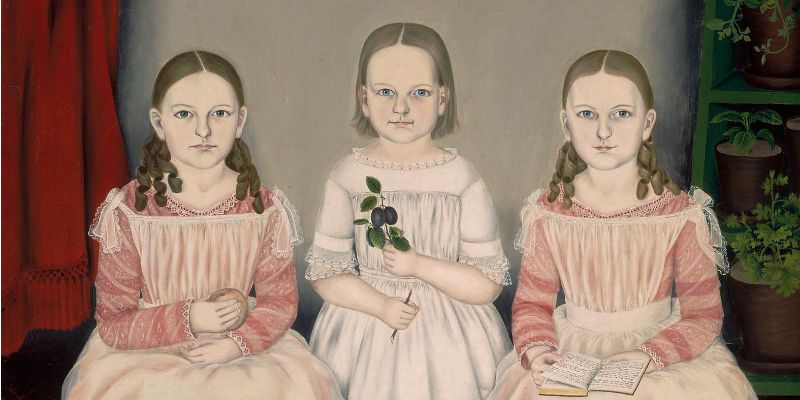Susan Catherine Moore Waters was a self-taught artist who had little formal training.
She paid her way through seminary school in Friendsville, Pennsylvania by producing drawings.
Married at 17 to William Waters, she relocated often according to her husband’s work and Quaker connections.
When her husband’s ill health meant that he could no longer work, she became the sole provider—and this is where her career as an artist blossomed.
Susan started painting commissioned portraits and giving lessons. Her early work earned enough to provide some financial security.


This painting of three of the twelve children of Otis Lincoln, an innkeeper from Newark Valley (near Binghamton), New York, is widely regarded as one of her finest achievements.
The three little girls (Laura Eugenie, age nine, Sara, age three, and Augusta, age seven) are arranged in a pyramid.
Wearing fancy dresses, ornamented with eyelet and lace, the girls hold pieces of fruit and a book—common in mid-19th-century child portraits and meant to convey their sweetness and enthusiasm for school.
The handsome furnishings, expensive-looking carpet, pretty plants and charming puppy—with its neatly aligned paws—create a pleasing image of domestic bliss. Contrast this with the startlingly serious expressions of the children.
She also wanted to develop as an artist.
In addition to portraits, she started painting landscapes and animals.

In 1866, after years of moving between temporary residences, the Waters finally settled in Bordentown, New Jersey, where she would create some of her best-known works of domesticated animals in pastoral settings.
These paintings would earn her recognition in her own lifetime, including an exhibit at the prestigious Centennial Exhibition in Philadelphia.
For a married woman in the 19th century, succeeding at being sole provider was a remarkable achievement.
To become recognized for her artistic talent in the male-dominated world of art was extraordinary.
Susan Waters’ strength of character would help her become a forward-thinker in the women’s suffrage movement and an animal rights activist.

References
- Wikipedia.org
- Museum of Fine Arts, Boston

